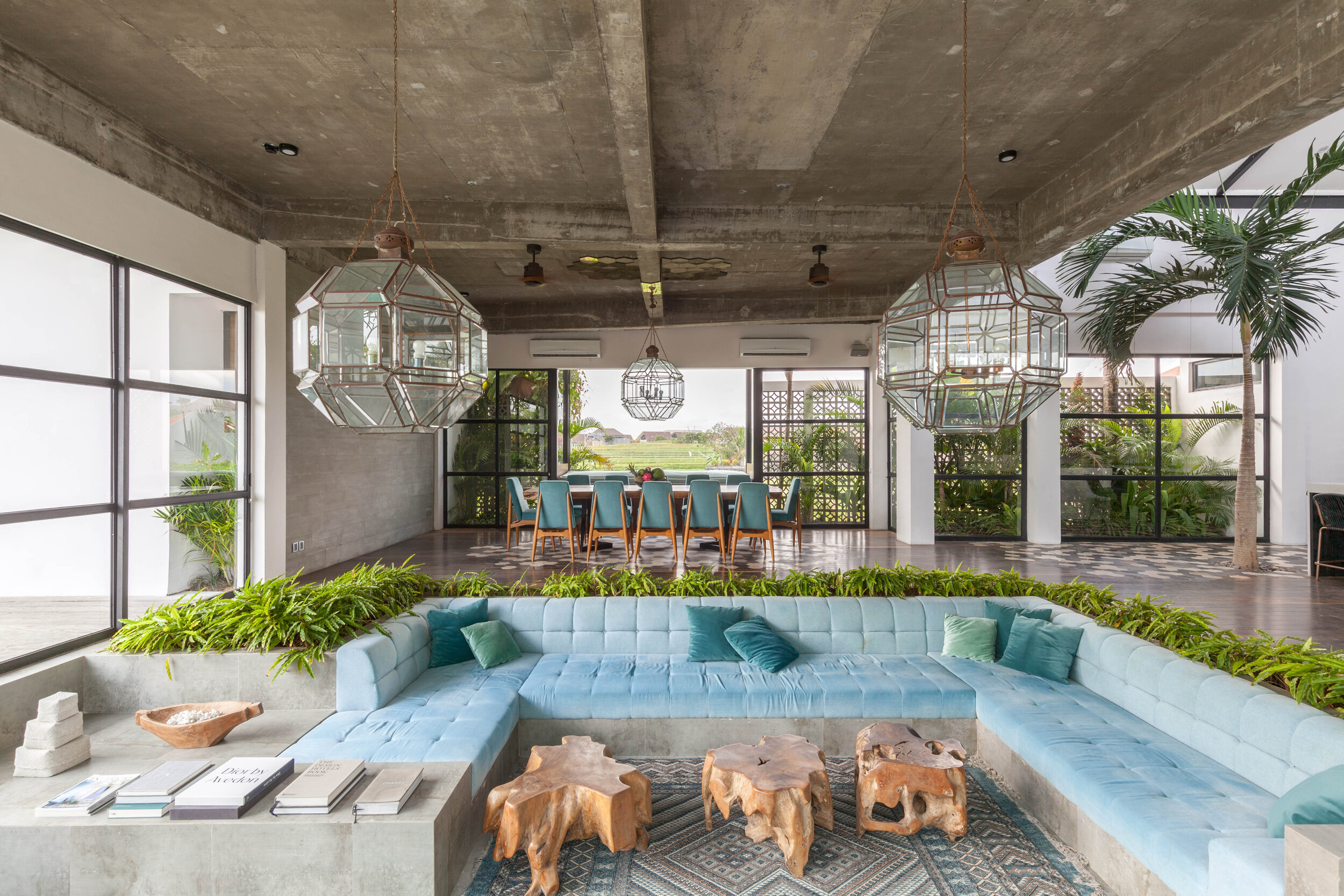WHAT BALI TAUGHT US ABOUT INDOOR-OUTDOOR LIVING
WHAT BALI TAUGHT US ABOUT INDOOR-OUTDOOR LIVING
How a small island changed the way we think about the boundaries between inside and outside
There's something about Bali that shifts your perspective on living. Maybe it's the way the warm air moves through open pavilions, or how naturally light filters through woven screens. Perhaps it's the sound of water always flowing somewhere nearby, or the way every space seems to breathe with the landscape around it.
During Elaina’s time living and working on this beautiful island (and Susanna’s frequent visits!), we learned lessons about indoor-outdoor living that have fundamentally changed how we approach design - not just in tropical climates, but here in Southern California and beyond.
The Philosophy: No Hard Lines
In Bali, the concept of "inside" and "outside" doesn't really exist the way we understand it in Western design. Traditional Balinese architecture flows seamlessly from interior spaces to courtyards, from covered pavilions to open gardens. There are no harsh transitions, no abrupt endings where indoor comfort stops and outdoor exposure begins.
Rather than simply removing walls or adding large windows, spaces acknowledge we're part of the natural world, not separate from it. Every home becomes a dialogue between shelter and openness, privacy and connection, comfort and adventure.
Lesson One: Let the Air Move
One of the first things you notice in Bali is how spaces breathe. Cross-ventilation is at the foundation of comfortable living. Traditional joglos (Javanese wooden houses) and modern villas alike are designed to capture and channel breezes, creating natural air conditioning that's both effective and beautiful.
What This Means for Your Home: Consider how air moves through your space, not just how it looks. Strategic placement of windows, doors, and even interior openings can create cooling breezes that make outdoor living comfortable even on warm days. In our California projects, we often design with prevailing winds in mind, creating natural cooling systems that reduce energy consumption while increasing comfort.
Lesson Two: Water as a Connector
In Bali, water is always doing double duty as both necessity and beauty. Reflecting pools extend the sky into courtyards, gentle fountains provide cooling and sound masking, and natural swimming pools blend seamlessly with garden landscapes.
But it's more than aesthetics. Water creates microclimates, cooling the air around it and adding humidity that makes outdoor spaces more comfortable. It also provides a sensory bridge between indoor and outdoor spaces- the sound of flowing water draws you outside and soothes you inside.
Bringing This Home: Even a simple water feature can transform how you experience your outdoor space. Whether it's a fountain visible from your kitchen window or a reflecting pool that extends your living room visually into the garden, water helps blur the boundaries between inside and out.
Lesson Three: Layered Privacy
Balinese design teaches us that privacy doesn't require walls. Traditional compounds use a series of layered screens, plants, and level changes to create intimate spaces within open frameworks. You can be completely private while still feeling connected to the sky, the breeze, and the sounds of nature.
Woven screens, bamboo panels, and strategic plantings create what are called"soft boundaries" which are barriers that provide privacy and definition without closing off spaces entirely. These elements filter views and sounds rather than blocking them completely.
The California Application: In our projects, if applicable, we aim to use similar principles with modern materials. Weathering steel screens, planted trellises, and carefully positioned trees create privacy while maintaining the flow between indoor and outdoor spaces. You can have intimacy without isolation.
Lesson Four: Outdoor Rooms with Real Comfort
Perhaps the biggest lesson Bali taught us is that outdoor living spaces need to be as comfortable and functional as indoor ones. Traditional Balinese bales (open-sided pavilions) serve as everything from dining rooms to bedrooms to meditation spaces. They're furnished and appointed with the same care as any interior room.
This means thinking beyond basic patio furniture. Outdoor spaces need thoughtful lighting for evening use, comfortable seating for extended lounging, protection from sun and rain, and surfaces that work for dining, working, or entertaining.
Creating True Outdoor Rooms: Consider how you actually want to use your outdoor space, then design accordingly. If you want to eat dinner outside, you need proper lighting and surfaces. If you want to work in the garden, you need comfortable seating and perhaps a writing surface. If you want to entertain, you need flexible seating arrangements and easy access to indoor amenities.
Lesson Five: Materials That Age Beautifully
Balinese architecture embraces the reality of weather and time. Materials like teak, natural stone, and woven fibers are chosen not despite their weathering characteristics, but because of them. These materials develop patina, soften with age, and become more beautiful over time rather than looking worn out.
This philosophy removes the anxiety around outdoor materials and maintenance. Instead of fighting against natural weathering, you choose materials that improve with exposure to the elements.
Material Choices That Work: Natural teak weathers to a beautiful silver-grey. Stone develops moss and patina that connects it to the landscape. Copper gutters and accents develop verdigris that adds character. Choosing materials that age gracefully means your outdoor spaces become more beautiful over time, not less.
Bringing Bali Home: Practical Applications
Start with Flow: Look at how you move between your indoor and outdoor spaces. Are there awkward transitions? Could you improve the physical and visual connection?
Consider Climate: Bali's lessons adapt to any climate. The principles of air movement, natural cooling, and seamless transitions work whether you're dealing with California sun, Southern humidity, or Northern winters.
Think in Layers: Create depth and interest in your outdoor spaces through layered planting, varied levels, and multiple seating areas rather than one large, undefined space.
Invest in Comfort: If you want to actually use your outdoor spaces, they need to be as comfortable as your indoor ones. This means proper cushions, adequate lighting, and weather protection.
The Deeper Shift
What Bali really taught us is that indoor-outdoor living is about a fundamental shift in how we think about home. It's about recognizing that our relationship with the natural world doesn't have to stop at our front door.
This philosophy has influenced every project we've worked on since, from beachfront homes where the ocean becomes part of the living space to urban houses where small courtyards bring the sky indoors. It's about creating homes that feel alive, connected, and in harmony with their surroundings.
Your home can be a sanctuary that embraces rather than excludes the natural world. And that connection to light, air, water, and growing things, might just be the missing element that transforms your house into a true home.
We'd love to help you explore how these principles might apply to your own space. Whether you're dreaming of a complete outdoor room or simply want to improve the connection between your indoor and outdoor living, these lessons from Bali can guide the way.




